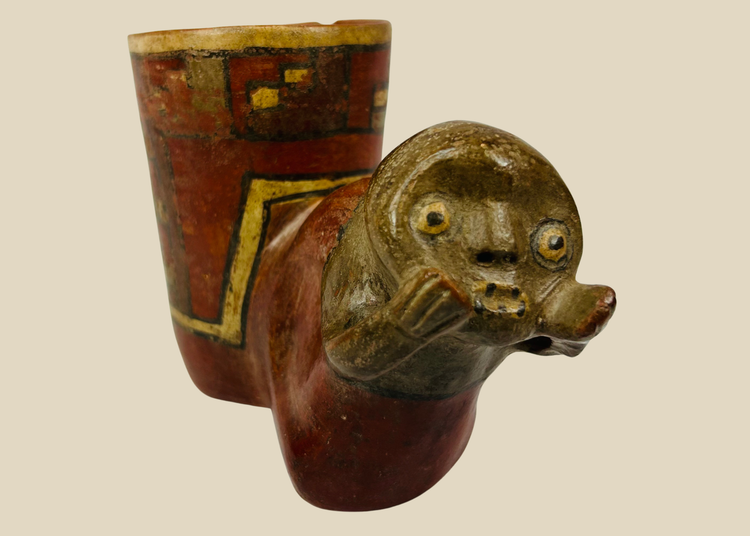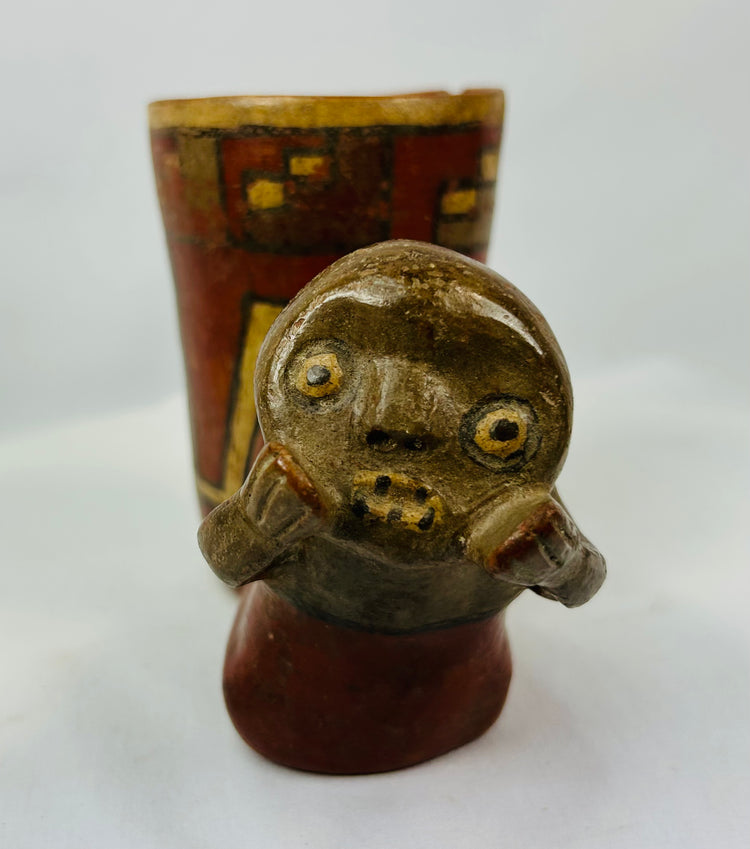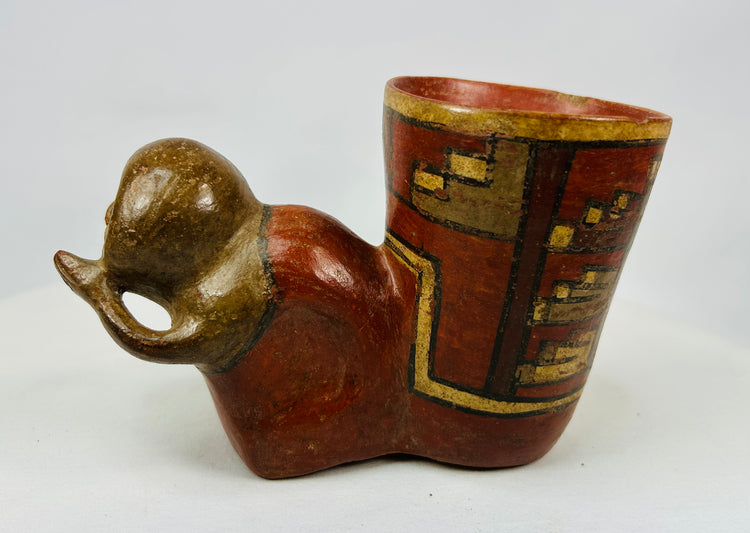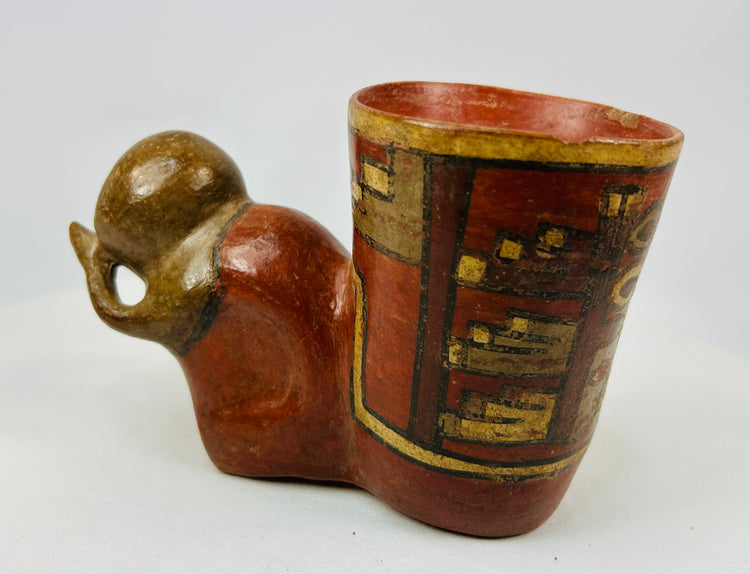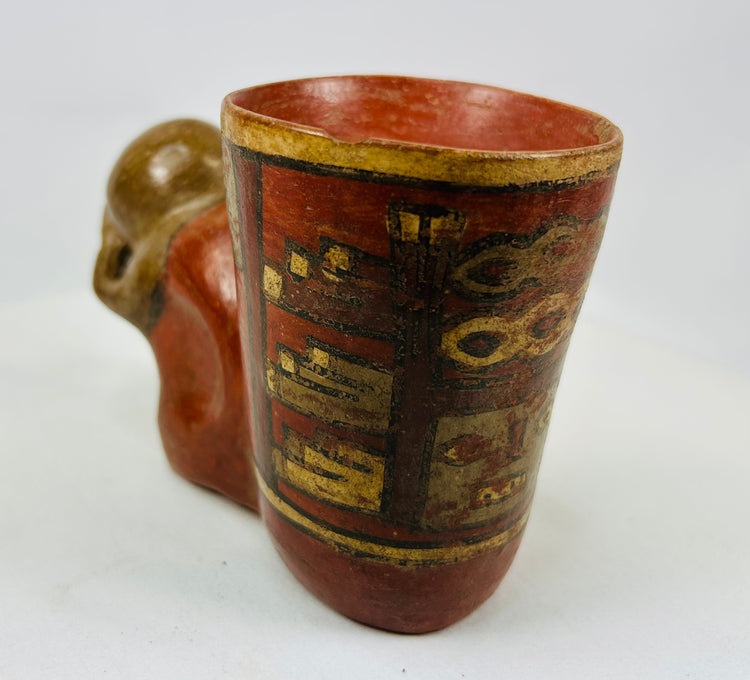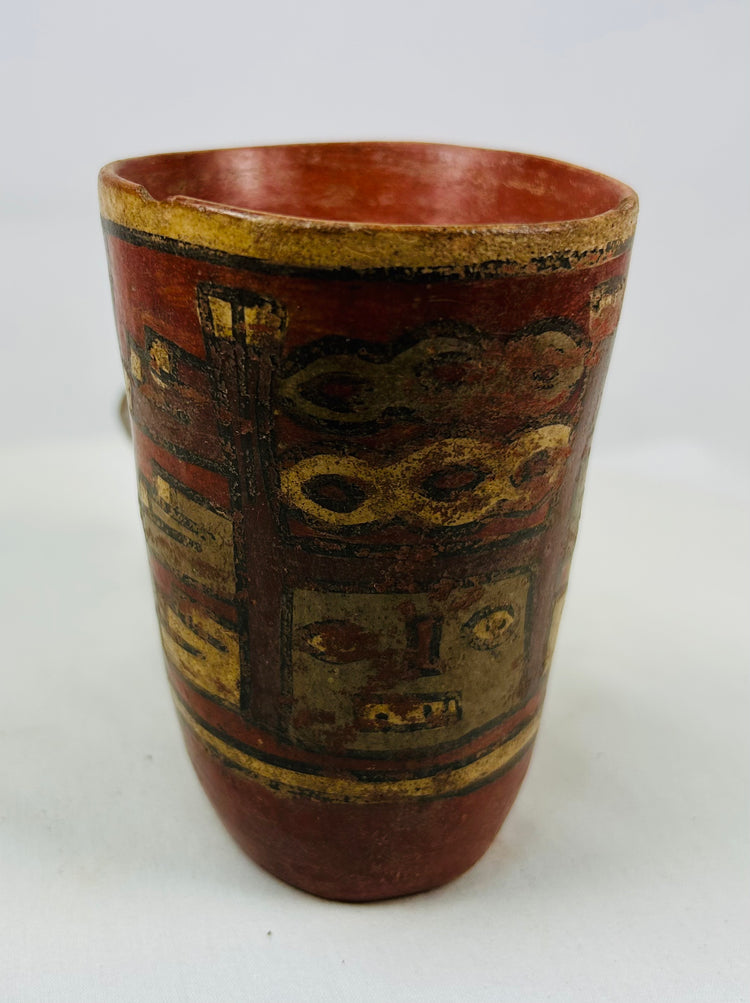Pre-Columbian | Polychrome Cup with Anthropomorphic Figural Mount | Peru | Circa 400–800 CE
Descripción
Más
Menos
Historical Context & Origin
Region: Southern Peru, likely Nazca or early Wari culture
Material: Painted terracotta with mineral pigments
Period: Circa 400–800 CE
Description
This exceptional Pre-Columbian ceremonial cup originates from southern Peru, likely associated with the Nazca or early Wari culture, dating between 400 and 800 CE. Expertly hand-modeled from terracotta, the vessel rises from a smooth rounded base and merges into the stylized form of an anthropomorphic figure—its expressive circular eyes and open mouth suggesting an act of offering or ritual invocation.
Painted with vibrant polychrome geometric motifs in red, black, yellow, and cream mineral pigments, the cup embodies the refined artistry and spiritual symbolism characteristic of Andean ceremonial ceramics. Its form and iconography indicate a role in ritual libations or funerary rites, serving as an offering to deities of fertility, water, or renewal.
Features
- Hand-coiled and burnished terracotta vessel with figural rear mount
- Polychrome geometric decoration typical of Nazca and early Wari iconography
- Integral anthropomorphic figure symbolizing divine offering
- Rich reddish-brown slip with preserved pigment traces
- Minor surface wear and mineral encrustation consistent with burial
Cultural Significance
Ceremonial cups of this kind were sacred instruments in Andean ritual life, embodying the connection between humanity and the divine. The integration of geometric patterning with figural representation reflects the dualism central to Andean cosmology—life and death, nature and spirit, man and god. Such vessels accompanied the elite in burial or temple contexts, ensuring protection and spiritual continuity beyond death.
Condition
Excellent preservation with minor restoration along the rim and shoulder. Pigment wear, surface encrustation, and patina consistent with great age and ancient excavation. No modern repainting or structural damage.
Dimensions (Approximate)
Height: 4.25 in
Length: 6.5 in
Width: 2.75 in
Age
Circa 400–800 CE (1,200–1,600 years old)
Learn More & Explore
Explore More Pre-Columbian Artifacts – Relic & Rarity Collection — Browse additional ceremonial vessels and effigy figures spanning ancient American civilizations.
Nazca Ceramics: An Introduction — Learn how the southern Peruvian Nazca culture perfected polychrome slip-painted pottery in ritual and funerary contexts.
Andean Civilizations – Ancient Ceramics — Discover the broader world of Andean highland ceramic art, its symbols, and cultural significance.
Descripción
Historical Context & Origin
Region: Southern Peru, likely Nazca or early Wari culture
Material: Painted terracotta with mineral pigments
Period: Circa 400–800 CE
Description
This exceptional Pre-Columbian ceremonial cup originates from southern Peru, likely associated with the Nazca or early Wari culture, dating between 400 and 800 CE. Expertly hand-modeled from terracotta, the vessel rises from a smooth rounded base and merges into the stylized form of an anthropomorphic figure—its expressive circular eyes and open mouth suggesting an act of offering or ritual invocation.
Painted with vibrant polychrome geometric motifs in red, black, yellow, and cream mineral pigments, the cup embodies the refined artistry and spiritual symbolism characteristic of Andean ceremonial ceramics. Its form and iconography indicate a role in ritual libations or funerary rites, serving as an offering to deities of fertility, water, or renewal.
Features
- Hand-coiled and burnished terracotta vessel with figural rear mount
- Polychrome geometric decoration typical of Nazca and early Wari iconography
- Integral anthropomorphic figure symbolizing divine offering
- Rich reddish-brown slip with preserved pigment traces
- Minor surface wear and mineral encrustation consistent with burial
Cultural Significance
Ceremonial cups of this kind were sacred instruments in Andean ritual life, embodying the connection between humanity and the divine. The integration of geometric patterning with figural representation reflects the dualism central to Andean cosmology—life and death, nature and spirit, man and god. Such vessels accompanied the elite in burial or temple contexts, ensuring protection and spiritual continuity beyond death.
Condition
Excellent preservation with minor restoration along the rim and shoulder. Pigment wear, surface encrustation, and patina consistent with great age and ancient excavation. No modern repainting or structural damage.
Dimensions (Approximate)
Height: 4.25 in
Length: 6.5 in
Width: 2.75 in
Age
Circa 400–800 CE (1,200–1,600 years old)
Learn More & Explore
Explore More Pre-Columbian Artifacts – Relic & Rarity Collection — Browse additional ceremonial vessels and effigy figures spanning ancient American civilizations.
Nazca Ceramics: An Introduction — Learn how the southern Peruvian Nazca culture perfected polychrome slip-painted pottery in ritual and funerary contexts.
Andean Civilizations – Ancient Ceramics — Discover the broader world of Andean highland ceramic art, its symbols, and cultural significance.
También te puede interesar
























